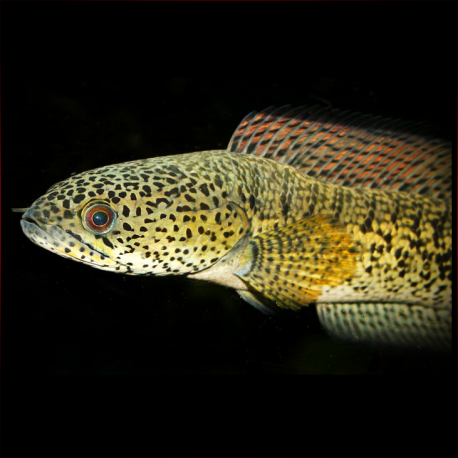More info
Datasheet
| Minimum Tank Size | 10000 litres / 2641.72 US gallons |
| Maximum Size | 90.0cm / 35.43inches |
| Temperature | 10°C / 50.00°F - 28°C / 82.40°F |
| Hardness | 2.02dgH / 36ppm - 20.00dgH / 357ppm |
| pH | 6.0-8.0 |
General Description
The Channa Barca, a member of the Channidae family, is highly sought after in the aquarium trade due to its distinctive characteristics such as lateral line scales, dorsal and anal fin rays, and vertebrae counts. This species of snakehead is recognized for its large scales on the head, resembling those found on snakes. Possessing supplemental breathing chambers, it can breathe atmospheric air, enabling it to survive out of water for extended periods.
Aquarium Setup
The Channa Barca requires a species-specific aquarium setup, with floating or overhanging vegetation or branches for surface cover. It is crucial to have a tightly-fitting hood with a gap for access to humid air. Natural seasonal temperature fluctuations are essential, mimicking defined winter and summer periods. This species should not be kept at a constant temperature, allowing for variations in feeding and water levels.
Behaviour
Being aggressively territorial towards its own species, the Channa Barca can display sudden acts of violence even in pairs or groups that have coexisted for a while. This behavior necessitates careful consideration when housing multiple individuals within the same aquarium, as conflicts can occur unexpectedly.
Feeding and Diet
An obligate predator, the Channa Barca primarily feeds on smaller fish and insects in its natural habitat. In captivity, this species adapts well to consuming dead alternatives, with some individuals accepting dried foods. Feeding young fish chironomid larvae, small earthworms, and prawn is recommended, while adults can be fed fish flesh, prawns, mussels, and earthworms. It is crucial to avoid feeding mammalian or avian meat to prevent excess fat deposits and organ degeneration.
Reproduction & Dimorphism
Reproduction in the Channa Barca is unrecorded but is likely to involve mouthbrooding. When males reach around 150 mm, they develop more extensive and intensely patterned dorsal fins. Sexing adults is possible by observing their dorsal fin development and head shape, with females generally having a broader head compared to males.
Habitat and Distribution
The Channa Barca is primarily found in vertical burrows near wetland margins that dry up during winter months. These burrows consist of entrance tunnels leading to larger underground chambers, used as refuges during dry periods. This species is indigenous to northeastern India, particularly in the states of Assam and Nagaland, inhabiting locales such as the Brahmaputra River near Goalpara. Due to its restricted range, specific microhabitat requirements, and conservation status, the Channa Barca is considered a concern for conservation efforts.

